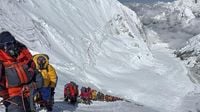For many adventurers, the allure of Mount Everest is irresistible—its towering height, breathtaking vistas, and the thrill of conquering nature’s extremes. But this October, what was supposed to be a holiday trek turned into a harrowing ordeal for hundreds of hikers, as an unexpected and powerful snowstorm swept across Everest’s eastern slopes, trapping more than a thousand people in freezing, life-threatening conditions.
The drama began on the night of October 4, 2025. According to multiple reports, including ABC News, the blizzard struck with little warning, blanketing the region in relentless snow, thunder, and lightning. Many of the trekkers were taking advantage of China’s eight-day National Day holiday, a period when tour groups to Tibet’s Everest region are typically booked solid months in advance. The remote Karama Valley, which leads to the eastern Kangshung face of Everest, was teeming with visitors eager for adventure. But few could have predicted the ferocity of the storm that would descend upon them.
“This scale of snow storm is very rare this time of the year for Mount Everest, even my local friends haven’t seen that for years,” said Qu Zhengpu, a 27-year-old experienced hiker, in an interview with ABC News. The eastern slopes, usually considered safer and more accessible to trekkers than the daunting northern climbing routes, became a trap as the snow piled up rapidly—by morning, it was more than three feet deep, reaching up to the thighs of many hikers.
One of those caught in the blizzard was Geshuang Chen, a 29-year-old astronomy photographer and mountaineering enthusiast. She described the terrifying night to the BBC: “When we woke up the next morning, the snow was already about a metre deep,” she said. “The snow was so heavy, the thunder and lighting made it terrifying. I barely slept for the whole night, I was so worried.” Her group, like many others, had checked the forecast, which only predicted one day of snowfall, and felt confident about the trek. But this year’s weather, as Chen put it, was “exceptional.”
Rescue efforts began in earnest on October 5, 2025. Hundreds of rescuers—local police, villagers, and even yaks—set out to clear paths and bring stranded hikers down the mountain. According to Chinese state media, about 350 hikers managed to reach the safety of Qudang or Tingri, small settlements at lower elevations, while contact was maintained with over 200 others still trapped higher up. However, the rescue teams faced significant challenges. As Qu Zhengpu pointed out, “there are more trekkers on the mountain with no cellphone signal, so it’s almost impossible for the rescue teams to get contact with them.” Some experienced hikers even decided to stay put and wait for the storm to pass, rather than risk the treacherous descent.
The blizzard’s timing was as remarkable as its intensity. October is typically a prime season for trekking in the Everest region, when the Indian monsoon draws to a close and the skies clear. The eastern side of Everest, known for its lush vegetation and alpine forests fed by the Kangshung glacier, is a magnet for tourists during China’s Golden Week. This year, though, the weather defied expectations. The storm was described by local guides as “highly unusual,” and forced officials to suspend ticket sales and entry to the entire Everest Scenic Area from late Saturday, as reported by The Independent.
The hikers who found themselves trapped were not attempting to summit Everest, but rather trekking on its lower eastern slopes—an area distinct from the base camp used by climbers. According to Straight Arrow News, the tourist camp where the hikers were stranded sits at about 16,000 feet, a formidable altitude where exposure to the elements can quickly become dangerous. The snowstorm cut off access to popular high-altitude routes, leaving many with little shelter and dwindling supplies.
The rescue operation was a true community effort. Villagers and local authorities joined forces, using yaks to transport supplies and help clear paths through the deep snow. When Geshuang Chen finally made it off the mountain, she was greeted in town by villagers offering warm milk tea and food—a gesture she described as “extremely grateful” for after her ordeal, according to ABC News.
But the challenges extended beyond the immediate Everest region. The same weather system that brought the blizzard to Tibet also battered neighboring Nepal and India. Heavy monsoon rains triggered landslides and flash floods in Nepal, blocking roads, washing away bridges, and killing at least 47 people since Friday, as reported by The Independent. In India’s Darjeeling district, disaster response teams searched for missing people after landslides killed at least 24, with television news showing rescuers clearing debris and destroyed infrastructure. Across the border in China, a typhoon forced over 15,000 residents to evacuate earlier that week, underscoring the region’s vulnerability to increasingly erratic weather patterns.
As the rescue operation unfolded, the world watched anxiously. The ordeal highlighted not only the dangers of high-altitude trekking but also the unpredictability of mountain weather—even in seasons typically considered safe. The region’s remoteness and patchy cellphone coverage complicated efforts to account for everyone. Yet, as rescue teams continued their work, the resilience and cooperation of local communities shone through.
For those who made it down safely, the experience was unforgettable. As Chen told the BBC, “Many people come here to hike during the Golden Week, but this year’s snow was exceptional.” It’s a stark reminder that even the best-laid plans can be upended by nature’s whims, and that the mountains—no matter how familiar—always demand respect.
In the aftermath, officials suspended tourism in the region until conditions stabilized. The focus remained on reaching the remaining trekkers and ensuring their safe return. As of the latest reports, hundreds had been led to safety, while contact persisted with others still awaiting rescue. The incident will likely prompt new discussions about safety protocols and emergency preparedness for trekking in the Himalayas, especially as climate change brings more unpredictable weather to the world’s highest peaks.
While the storm’s fury has subsided, its impact will linger in the memories of those who endured it—and in the lessons learned by all who venture into Everest’s shadow.






